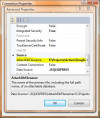If I have 2 or more tables and I need to have another table that is related to the data in those tables...how would I achieve that?
As an example:
Table A and B have totally different data and aren't directly related at all. I would like Table C to relate to a record in either Table A OR Table B but not both. Like, if there is an entry in Table C it could reference the PK in Table A or Table B...but since those are different tables, the PK can duplicate and I'm stuck figuring out (which key is which?) would it be better to have columns in Table C called something like "TableAKey" and "TableBKey" and have a relationship between those columns and the respective tables? If the relationship belongs to one table and not the other, one of them is null and the other isn't?
Any ideas?




